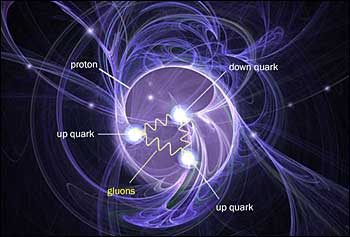Recently, researchers performing proton collision at the Large Hadron Collider (LHC) in Europe provided proof for the existence of a sought-after particle known as the Higgs boson, which is believed to be responsible for the mass of matter.
 The three valence quarks that make up each proton account for about one percent of its mass; the rest comes from interactions among the quarks and gluons.
The three valence quarks that make up each proton account for about one percent of its mass; the rest comes from interactions among the quarks and gluons.
Although the Higgs particle may be accountable for the mass of basic particles like quarks, quarks alone are not responsible for the mass of the majority of the visible matter in the universe. It is important to understand the interaction between quarks and gluons to know the mechanism that holds all visible matter together. This is the focus of quark matter physics and the Quark Matter 2012 international conference, which is being conducted from August 12 to 18, 2012, in Washington, DC.
Peter Steinberg from the Brookhaven National Laboratory of the U.S. Department of Energy stated that researchers are exploring the 99% of the visible universe’s mass that is not elucidated by the Higgs. Visible matter is made up of atoms whose mass is mainly contributed by the protons and neutrons, which form the atomic nuclei, and virtually nothing is contributed by the electrons orbiting the nucleus. However, the neutrons and protons, each composed of three quarks, have a mass higher than the total mass of their constituent particles.
According to physicists, the extra mass is a result of the way of interaction of the quarks through the exchange of gluons, which are zero-mass particles holding the quarks together through nature’s strongest force, and interplays between the gluons themselves. To tease apart the characteristics of this force that becomes stronger when the subatomic quarks are pulled apart, researchers increase the speed of atomic nuclei or heavy ions close to that of light, at which the gluons turn out to be dominant and lead to head-on collisions at particle accelerators such as the LHC in Europe and the Relativistic Heavy Ion Collider at the Brookhaven National Laboratory. Conditions like those of the early universe are recreated by these collisions prior to the joining of quarks to create protons and neutrons.
Exploring the characteristics of free quarks and gluons in the primordial quark-gluon plasma could be helpful in knowing the strong force and its significant contribution towards mass during the coalescence of the particles to create ordinary matter.